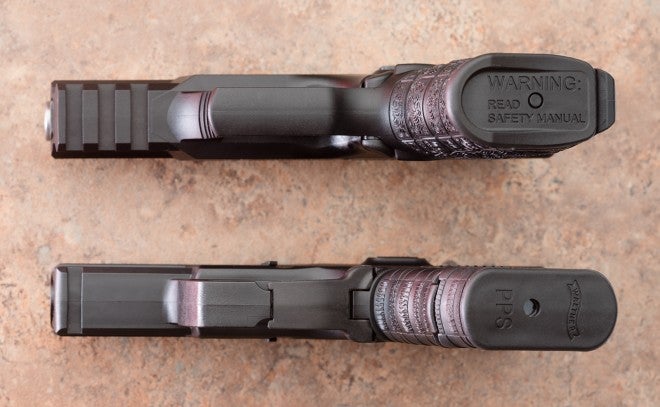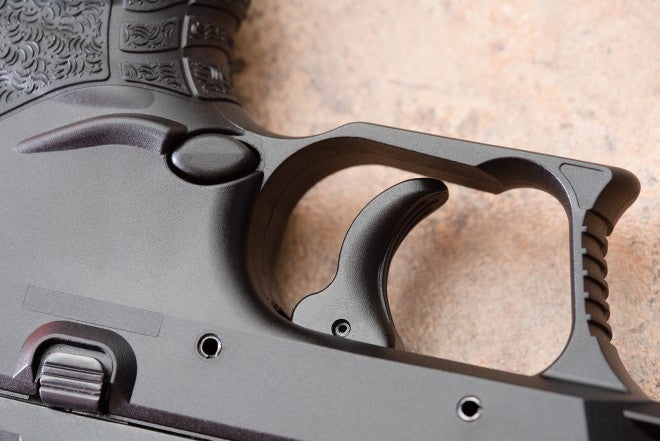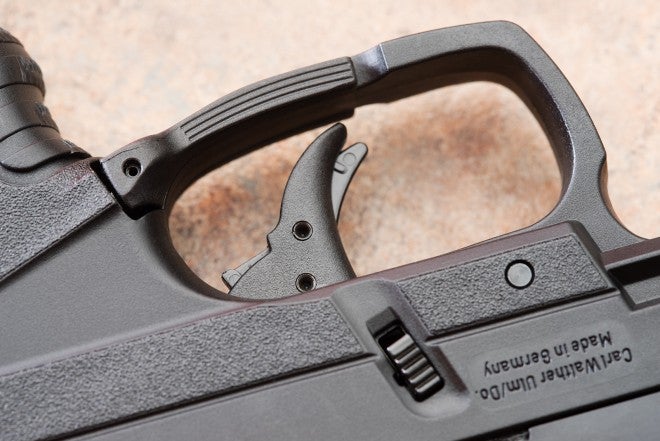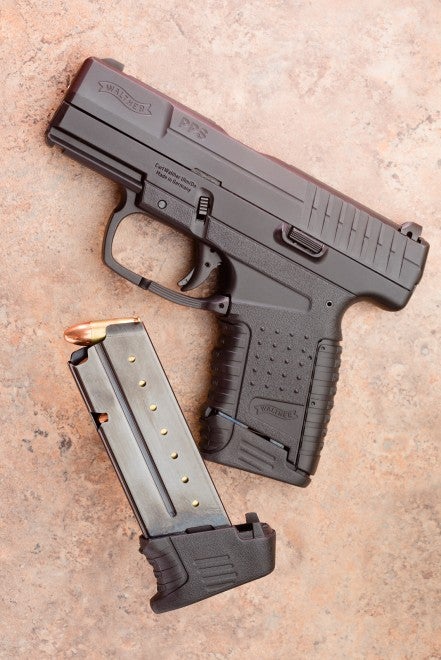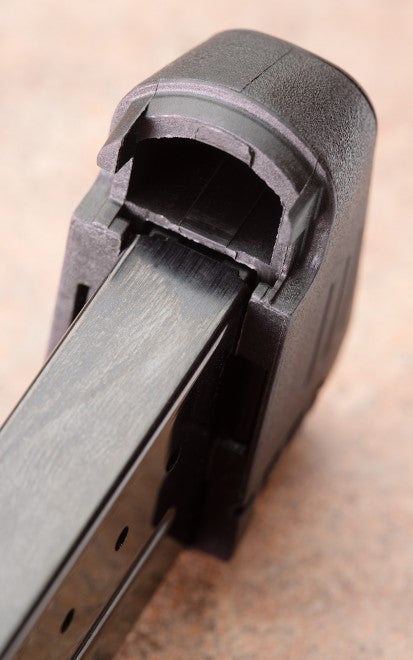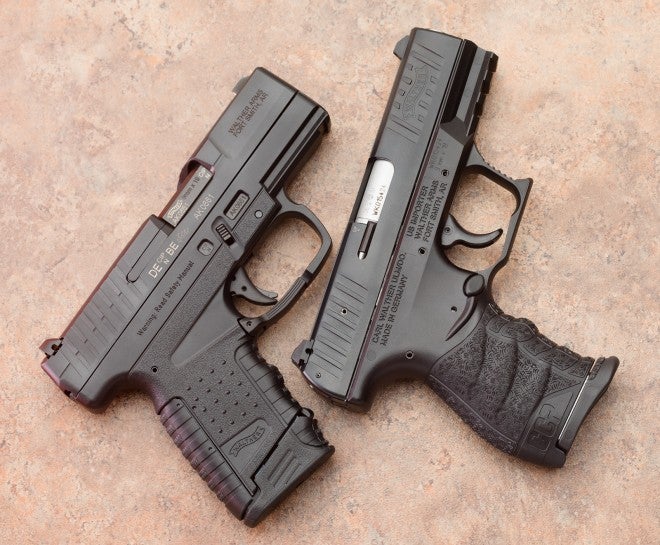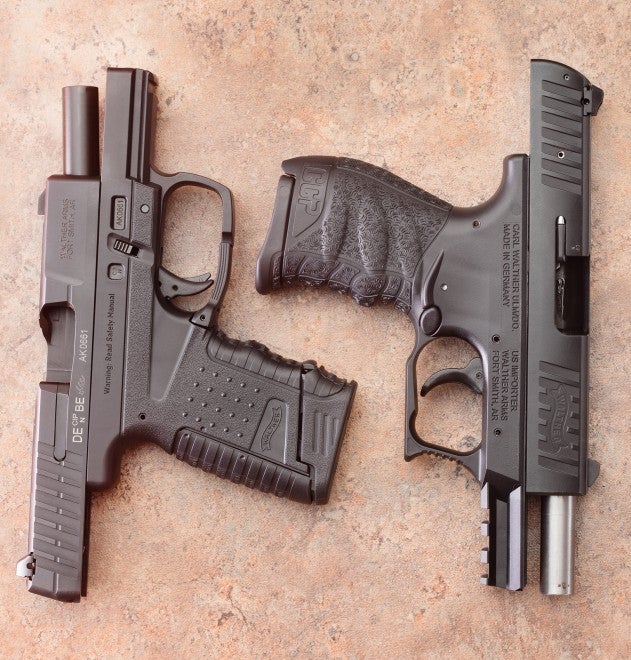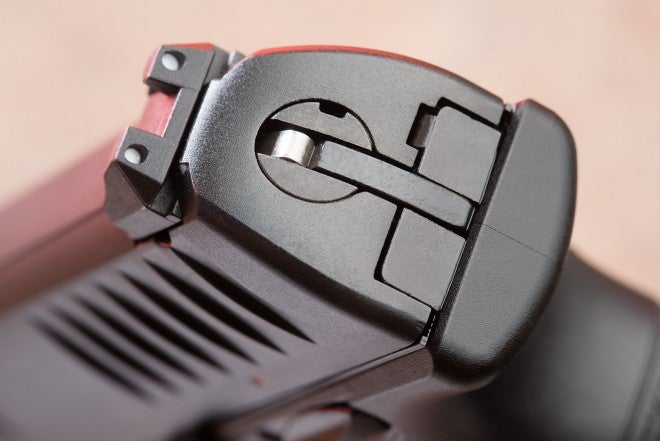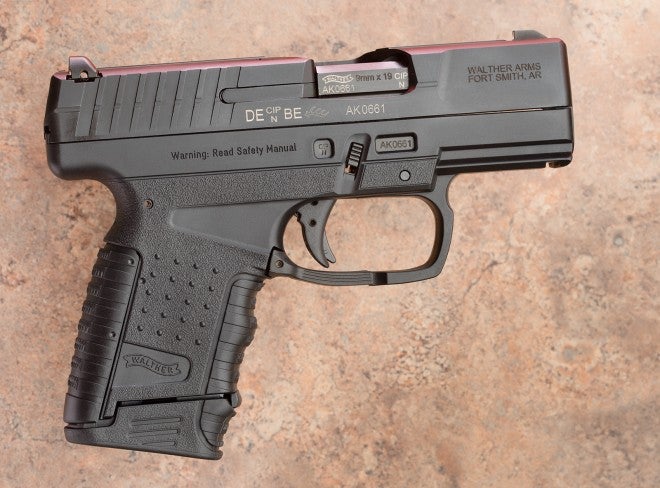Walther CCP vs PPS: Same Goal, Different Ways to Achieve It
Oleg Volk 07.20.15
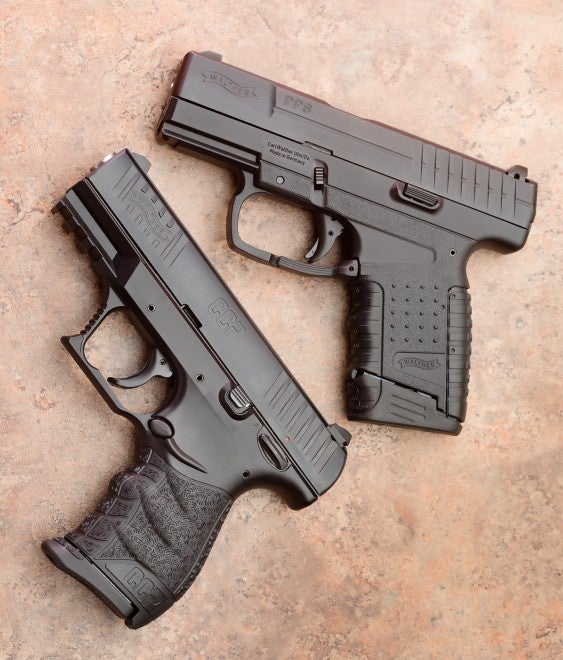
Walther has two very different entries in the subcompact pistol category. PPS is a conventional short recoil pistol with a short reset trigger. CCP is a gas-retarded blowback pistol with fixed barrel and a long reset trigger that isn’t double action. While similar in size, weight, and purpose, the two guns are about as different in the manual of arms and feel as can be.
PPS (bottom) is a little thinner and lighter. The difference is probably not significant for carry. PPS is blocky and angular, with interchangeable backstraps. It fits even tiny hands. CCP is more rounded and feels more like a revolver. The long trigger pull with equally long reset reminded me of a good Colt revolver at first. With use, it seemed to get more gritty rather than less.
As double action pulls go, it’s fairly light. Reversible magazine release is pretty conventional on the CCP, as is the slide stop. Not so on the PPS.
At first, I couldn’t figure out how to operate the flapper magazine release of the PPS. My thumb simply could not reach the front of it to get enough leverage. Later, I realized that it was designed to be operated by the index finger and works very well for that. For a person who is used to thumb mag releases, it takes a little range time to re-learn. Like most Sig pistols (which have de-cocker where most other guns position the slide stop), PPS should not be mixed with dissimilar designs for main+backup carry to avoid confusion.
PPS comes with 7 round and 8 round magazines, which have the same metal body and different floorplates. On the 7-rounder, the last witness hole is decorative. The 8-rounder I had did not work reliably, causing jams at least twice per 8-shot load. 7-rounder was 100% reliable with a wide variety of ammunition. For concealed carry, a shorter magazine makes more sense in any case, and reliable operation can be restored by replacing the floorplate with the 7 round part.
Both floorplates have “teeth” probably meant to position the magazine more rigidly within the grip. These protrusions get in the way during the loading process and pose a pinching risk to shooters with large hands. They can probably be removed without loss of functionality. CCP magazines hold 8 rounds and are easier to fill.
Both pistols have similar, quite functional three-dot sights and both have very good mechanical accuracy. Slow fire, there’s not much of a challenge in shooting one-inch groups with either. Although PPS trigger is fairly heavy, it’s crisp and has a clear re-set, and the pistol sits well in hand. CCM also points well, but the sear release is less predictable, so follow-through is more important.
As you can see, PPS barrel tilts during cycling, while CCP is fixed in place. CCP has a fixed barrel and the slide is held closed by gas pressure, a design similar to the old HK P7 series. It produces softer recoil and less muzzle flip, but at the cost of trapping more heat in the gun.
CCP also has a rather off take-down latch at the back of the slide, to be popped with the supplied tool or with a flat screwdriver. The process requires some manual dexterity. By contrast, PPS take-down is conventional with the latch located just above the trigger.
In the most basic form, PPS is a 19.5oz 7+1 pistol with 3.2″ barrel. CCP is a 22oz 8+1 pistol with 3.5″ barrel. Close enough to fit the same niche. The two feel pretty different at the range.
PPS is definitely slower to return on target due to the pronounced muzzle flip. It worked reliably and shot accurately with all kinds of ammunition, from loud 50gr Liberty frangibles to aluminum cased CCI147gr subsonics. Groups at 7 yards ranged from an inch to two inches, and seemed to depend more on the shooter’s concentration than on the load. CCP did not cycle 50gr ammo at all but ran like a champ with every other load. CCP was quicker back on target, but the trigger was far slower to cycle. The trigger pull reminded me of two skeletons getting on without lubrication, and much attention was needed to avoid unexpected discharge during the long travel. Revolver shooters definitely have an advantage in running this gun. While CCP trigger feels like DAO, it activates a striker and doesn’t have re-strike capability. The slide of the CCP was definitely easier to rack than that of PPS.
While gas retarded blowback does reduce felt recoil, it made extensive range practice difficult. Three magazines, 24 rounds total, were enough to warm the pistol to an uncomfortable temperature. I could probably fire another 16 rounds before the heat became unbearable. That’s not a serious problem for a defensive pistol, as few people carry more than one spare magazine. However, if more than three magazines were fired during training, returning the pistol to an IWB or pocket holster might pose a challenge to the person wearing it. HK P7, being rather heavier, would heat up slower. I hoped that the plastic frame would insulate my hands better than it did.
In sum, CCP is a functional replacement for a K frame revolver. It’s slightly smaller, with higher capacity and much reduced recoil, but retaining the revolver style trigger pull. PPS is a competitor to S&W Shield, Glock 43, or Springfield XDM. It’s very likely that a person would have a strong preference between these two. I expected to prefer the CCP, but the quick overheating and the gritty trigger steered me towards PPS instead. Lower than expected recoil, crisp trigger, and smaller size all added up to a better feel despite greater muzzle jump. On the other hand, CCP is a superior pistol for one-handed shooting, as it’s less sensitive by far to limp-wristing. It would be a superior choice for recoil-sensitive shooters.
